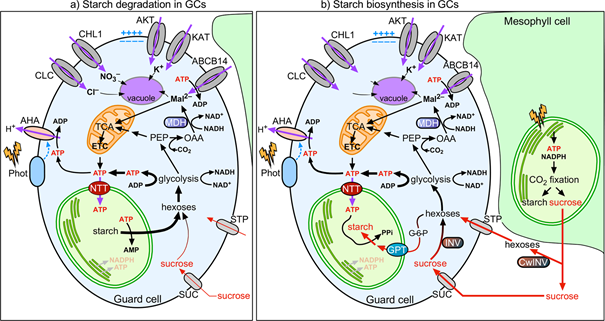How guard cells obtain energy
- D-USYS
- Institute of Integrative Biology
Sunlight triggers stomata, which are tiny pores on plant leaves, to open. This let CO2 in and O2 out to boost photosynthesis. An important role in this stomatal movement process is played by the guard cells (GCs) that surround the stomatal pore. But where do the GCs take their energy from? Researchers from University of Hong Kong and ETH Zurich discovered GCs’ secret source of fuel.
The opening of stomata consumes a large amount of adenosine triphosphate (ATP), the cellular energy currency. But the sources of ATP for stomata opening remained obscure. Some studies suggested that guard cell chloroplasts (GCCs) carry out photosynthesis and export ATP to the cytosol to energise stomata opening. In leaf mesophyll chloroplasts, ATP and NADPH (nicotinamide-adenine dinucleotide phosphate) are generated from photosystems, which are used as fuel for fixing CO2.
An unexpected observation
By employing in planta fluorescence protein sensors, the team of Boon Leong Lim at the University of Hong Kong (HKU) was able to visualise real-time production of ATP and NADPH in the mesophyll cell chloroplasts (MCCs) of a model plant, Arabidopsis thaliana. "However, we could not detect any ATP or NADPH production in GCCs during illumination. Puzzled by this unexpected observation, we contacted an expert in guard cell metabolism, Diana Santelia from ETH Zurich, for a collaboration," Lim said. Over the past decade, the Santelia lab provided deep and important insights into starch and sugar metabolism in GCs.
GCs rather receive than provide sugars
In joint efforts, the team shows that unlike mesophyll cells (MCs), GC photosynthesis is poorly active. Sugars synthesised and supplied by MCs are imported into GCs and consumed by mitochondria to generate ATP for stomatal opening. Unlike MCCs, GCCs take up cytosolic ATP via the nucleotide transporters (NTTs) on chloroplast membrane to energise starch synthesis in daytime. At dawn, while MCs start to synthesise starch and export sucrose, GCs degrade starch into sugars to supply energy and increase turgor pressure for stomatal opening. Hence, the function of GCCs to support starch turnover is important for stomatal opening. While MCs fix CO2 in chloroplasts via the Calvin–Benson–Bassham (CBB) cycle, anaplerotic CO2 fixation in the cytosol is the main pathway of CO2 assimilation in GCs, where the downstream product malate is also an important solute to increase turgor pressure for stomatal opening. In conclusion, GCs behave more like a sink (receive sugars) than a source (provide sugars) tissue (e.g. MCs). Their function is tightly correlated with that of MCs to efficiently coordinate CO2 uptake via stomata and CO2 fixation in MCs.
A joint effort
"I was very excited when Lim contacted me asking to collaborate on this project," Diana Santelia said. "We have been trying to clarify these fundamental questions using molecular genetics approaches. Combining our respective expertise has been a winning strategy," she continued. Sabrina Flütsch, the co-first author of the article and former PhD student of Santelia’s group confirmed: "Throughout the past seven years of researching guard cell metabolism, I have often faced the question of how guard cells obtain their energy and how starch metabolism integrates with the energy demand. I was thrilled to join forces with the Lim lab and combine our experimental expertise to try to close this critical knowledge gap in guard cell research." For her doctoral thesis, Starch metabolism in guard cells and its impact on stomatal function, Flütsch has been awarded with this year’s ETH medal.
Reference
Lim SL, Flütsch S, Liu J et al.: Arabidopsis guard cell chloroplasts import cytosolic ATP for starch turnover and stomatal opening. Nature Communications 13: 652, 2022. doi: external page 10.1038/s41467-022-28263-2
